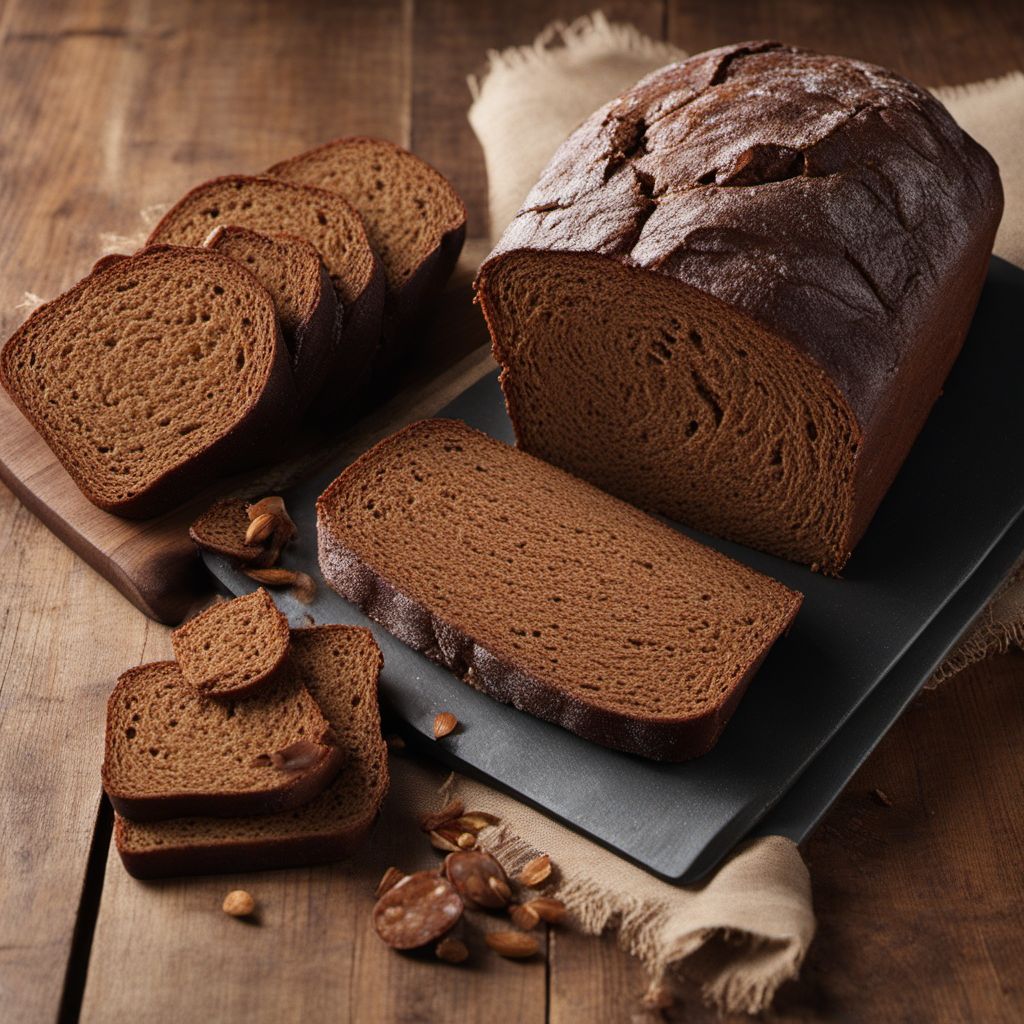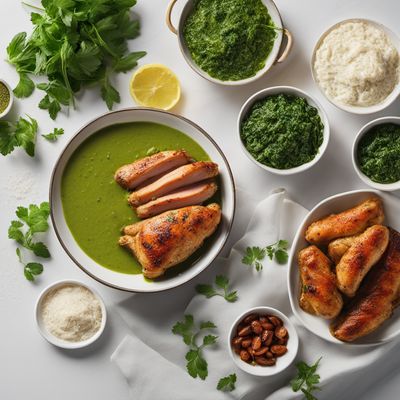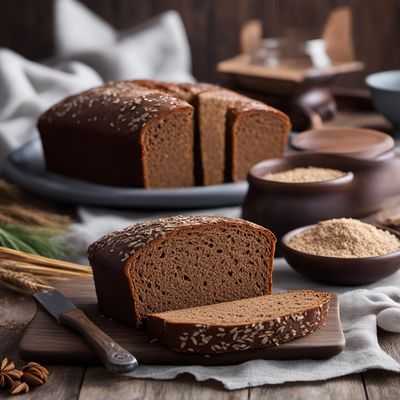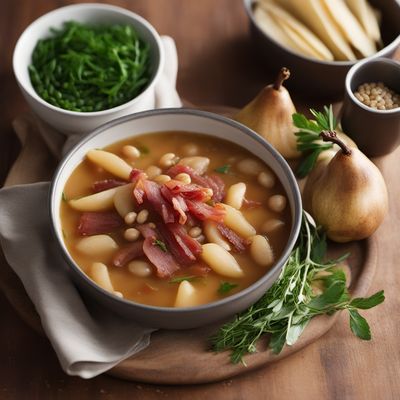
Recipe
Homemade German Pumpernickel Bread
Hearty Rye Delight: Homemade German Pumpernickel Bread
4.3 out of 5
Indulge in the rich flavors of German cuisine with this homemade Pumpernickel bread recipe. Made with traditional ingredients and techniques, this dark and dense bread is a staple in German households.
Metadata
Preparation time
20 minutes
Cooking time
2-3 hours
Total time
2 hours 20 minutes (including rising time)
Yields
8 servings
Preparation difficulty
Medium
Suitable for
Vegetarian, Vegan (if the sourdough starter is vegan), Dairy-free, Egg-free, Nut-free
Allergens
Gluten
Not suitable for
Gluten-free (contains rye and wheat flour)
Ingredients
-
2 cups (250g) rye flour 2 cups (250g) rye flour
-
1 cup (120g) whole wheat flour 1 cup (120g) whole wheat flour
-
1 cup (120g) bread flour 1 cup (120g) bread flour
-
1 1/2 cups (355ml) warm water 1 1/2 cups (355ml) warm water
-
1/4 cup (60ml) natural sourdough starter 1/4 cup (60ml) natural sourdough starter
-
2 tablespoons (30ml) molasses 2 tablespoons (30ml) molasses
-
2 teaspoons (10g) salt 2 teaspoons (10g) salt
-
1 teaspoon (5g) caraway seeds (optional) 1 teaspoon (5g) caraway seeds (optional)
-
Cornmeal, for dusting Cornmeal, for dusting
Nutrition
- Calories (kcal / KJ): 180 kcal / 753 KJ
- Fat (total, saturated): 1g, 0g
- Carbohydrates (total, sugars): 39g, 3g
- Protein: 5g
- Fiber: 6g
- Salt: 1.2g
Preparation
-
1.In a large mixing bowl, combine the rye flour, whole wheat flour, and bread flour.
-
2.In a separate bowl, mix the warm water, sourdough starter, and molasses until well combined.
-
3.Pour the wet mixture into the dry ingredients and stir until a shaggy dough forms.
-
4.Add the salt and caraway seeds (if using) and knead the dough for about 10 minutes until it becomes smooth and elastic.
-
5.Shape the dough into a ball and place it in a greased bowl. Cover with a damp cloth and let it rise in a warm place for 2 hours.
-
6.Preheat the oven to 250°C (480°F) and place a baking stone or baking sheet inside.
-
7.Punch down the risen dough and shape it into a round loaf. Dust a baking peel or the back of a baking sheet with cornmeal and transfer the loaf onto it.
-
8.Score the top of the loaf with a sharp knife and sprinkle some additional caraway seeds if desired.
-
9.Carefully transfer the loaf onto the preheated baking stone or baking sheet and bake for 10 minutes.
-
10.Reduce the oven temperature to 120°C (250°F) and continue baking for 2-3 hours until the bread is firm and sounds hollow when tapped on the bottom.
-
11.Remove the bread from the oven and let it cool completely on a wire rack before slicing.
Treat your ingredients with care...
- Rye flour — Rye flour tends to absorb more liquid than wheat flour, so adjust the dough consistency by adding a little more water if needed.
- Sourdough starter — Ensure your sourdough starter is active and bubbly before using it in the recipe. If it needs refreshing, feed it with equal parts flour and water and let it ferment until active.
- Caraway seeds — Caraway seeds add a distinct flavor to the bread. If you prefer a milder taste, you can omit them.
Tips & Tricks
- For a stronger flavor, let the dough ferment in the refrigerator overnight before shaping and baking.
- To achieve a darker crust, brush the loaf with water before baking and sprinkle it with additional rye flour.
- Pumpernickel bread tastes even better the next day, so consider making it in advance.
- Store the bread in a paper bag or bread box to maintain its texture and prevent it from drying out.
- If you don't have a baking stone, you can use an inverted baking sheet as a substitute.
Serving advice
Serve the Pumpernickel bread sliced thin and topped with cream cheese, smoked salmon, and fresh dill for a classic German-inspired appetizer. It also pairs well with hearty soups and stews.
Presentation advice
To showcase the rustic beauty of the Pumpernickel bread, present it on a wooden cutting board or a bread basket lined with a clean kitchen towel. Optionally, sprinkle some caraway seeds on top for an extra touch.
More recipes...
For Pumpernickel
For German cuisine » Browse all

Schwarzer Magister - German Black Forest Cake
Decadent Delight: Indulge in the Richness of German Black Forest Cake

Hearty German Kale and Sausage Stew
Savory Kale Delight: A German Comfort Classic

Frankfurt Green Sauce with Herb-Roasted Chicken
Herb-Infused Delight: Frankfurt's Green Sauce with Roasted Chicken
More German cuisine dishes » Browse all

Stollen
Stollen is a traditional German fruitcake that is often served during the Christmas season. It is a sweet and flavorful cake that is typically...

Proben
Proben is a Filipino street food made from grilled chicken or pork intestines. It is a popular snack or appetizer that is usually served with...

Bienenstich
Bee Sting Cake
Bienenstich, also known as "bee sting cake," is a traditional German dessert that is made with a sweet yeast dough, a creamy filling, and a...



